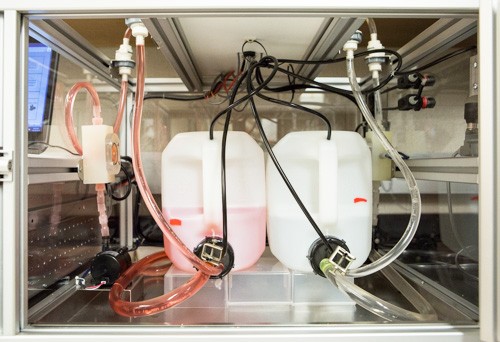GVSU students research flow battery technology

GVL / Courtesy GVNow GVSU Vinazene Project. Prototype testing in Panos Science Hall. Flow battery Technology.
Jan 8, 2015
As technology continues to advance, researchers are looking for new ways to improve how power is harnessed and made readily available to the public. Included in this search are Grand Valley State University researchers who are looking to explore the unique relationship energy has with technology.
At GVSU, student researchers, under the leadership of chemistry professor Andrew Lantz, are working on the idea of flow battery technology which is powered by organic electrolytes. This project is a collaboration with Vinazene Inc., started by Paul Rasmussen from the University of Michigan.
“The students are the ones actively testing the flow cell setup that we have,” Lantz said. “I am involved in mentoring and training them, but the students are the ones collecting data and doing the actual lab research.”
So far, the project has involved four GVSU students, with plans to allow the opportunity for another student to join in the summer. Currently, one student is working on the project.
According to Lantz, flow batteries are a possible solution to harnessing consistent renewable energy. He said wind farms and solar panels, for example, are great sources of power, but due to their natural limitations, creating a way to store the energy so that it can be used at will when the wind is not blowing or the sun is down is crucial.
“A lot of times you need energy when those power sources aren’t producing energy, so you need to be able to store energy for a long period of time,” Lantz said.
Lantz said flow batteries can vary from being the size of a tabletop to being as large as a tennis court. For this project, GVSU chemistry students are creating and testing organic electrolytes for use in the batteries.
“I became very interested in learning more about electrochemistry and how to use different instrumentation that I would not otherwise been able to learn,” said Emily Peters, one of the researchers. “This project allowed me to learn so many different techniques and applications that I knew it would be an experience worth taking advantage of.”
Though the research involves the fundamental chemistry going on in the battery itself, it also allows for interested students to take the knowledge they acquire and apply it to something useful for others. Those involved in the project are looking at developing organic electrolytes that will work in the batteries.
“We are looking at how small changes in the structure of the compounds affects their performance in the flow cell,” Lantz said. “Ultimately our big picture is, if we can find a good series of organic compounds that have high voltage output and energy density, we want to create a flow cell apparatus to match the chemistry. The types of materials in the flow cell changes based on your electrolyte so we have to modify the flow cell to match that.”
According to Lantz, GVSU is also working with research consultants. William Schroeder, involved in the synthesis of compounds, and John Schroeder, involved with the design and building of the prototype flow cell units, are working with team members to create maximum results. Lantz said there are countless changes that can be made to the compounds, and they are trying to find a makeup that will produce the results they are looking for
“We are testing a variety of these organic compounds to see how well they store energy over time and how we can discharge it,” Lantz said.






















